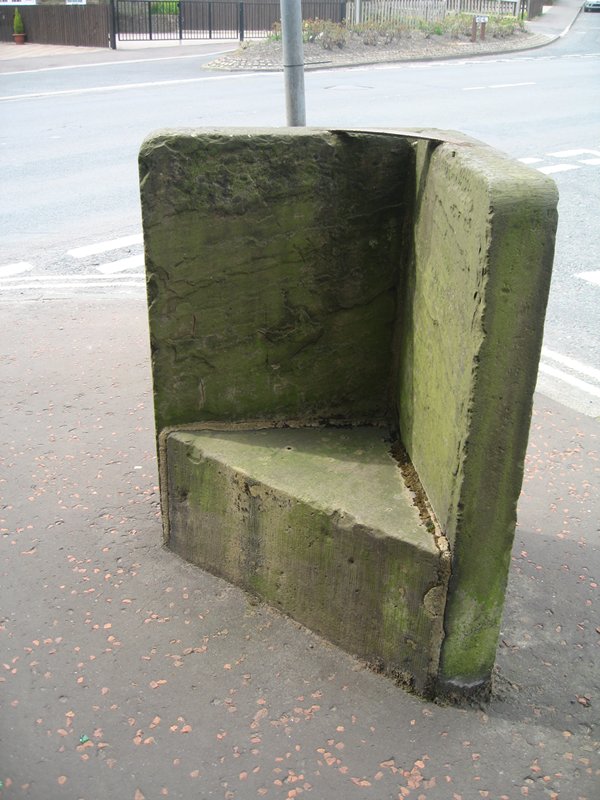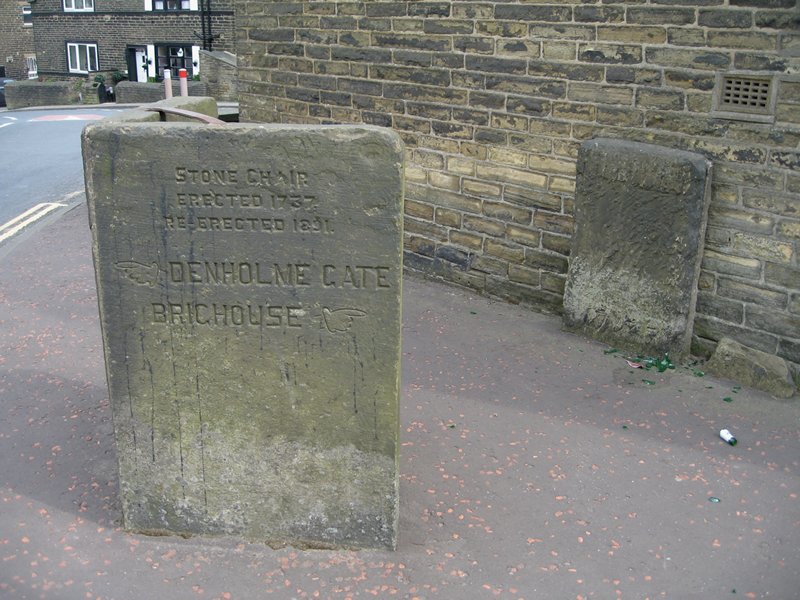Guide Stones
The Stone Chair
In the village of Shelf, on the A6036 between Halifax and Bradford in West Yorkshire, is an area called Stone Chair. And on an older line of the road, originally the Wibsey Bankfoot and Lidget Branch Turnpike, just north of the Stone Chair roundabout, sits the stone chair that gave its name to the area.
on an older line of the road, originally the Wibsey Bankfoot and Lidget Branch Turnpike, just north of the Stone Chair roundabout, sits the stone chair that gave its name to the area.
The present structure, a Grade II listed monument, dates from 1891. It consists of two large upright stone slabs set at right-angles to each other, and joined at the top by an iron strap. Between the two is a large triangular stone block which acts as a seat - hence the name.
The original stone chair, however, was erected in 1737. This date would suggest it was put up following directions from the county Justices to local township surveyors to erect stoops to assist travellers at cross-ways - instructions most recently repeated in 1733.
The highways surveyor for the Shelf township at the time of its erection was William Clayton, a blacksmith who also seems to have been the publican of the Duke of York Inn, across the road from the site of the stone chair. His yearly accounts survive, which record that "a gide erecting and seting up" cost 4s-6d, and "aile when stone was sett up" was 1s-6d. Clayton died in 1766 and was buried in nearby Coley Church.
The first edition Ordnance Survey 6" map (published 1854) shows what it calls a milestone, giving the following destinations and distances: Huddersfield 6, Keighley 8, Halifax 2 and Bradford 4. These are not statute miles but the longer traditional miles, which are usually found on guide-stoops of the period - unlike the miles shown on actual milestones.
In the 1820s, however, the new line of the turnpike had been constructed, and the stone chair had lost its original purpose - whatever that was:  possibly a resting-place for people (or, at least, one person) waiting for stage-coaches or other transport - and by the 1880s it had fallen apart, or even been destroyed.
possibly a resting-place for people (or, at least, one person) waiting for stage-coaches or other transport - and by the 1880s it had fallen apart, or even been destroyed.
In 1890 local antiquarian and writer Harry Speight claimed to have unearthed one of the stone slabs of the original chair from beneath a heap of rubbish on its original site; its inscription had been defaced. From Speight's description and illustration of the original chair (and there is no other source to confirm its original appearance) a new one was erected in 1891, with new stone slabs. The destinations differ from those on the OS map: Bradford and Halifax remain, but Keighley and Huddersfield have been replaced by the nearer Denholme Gate and Brighouse. Speight's defaced 1737 slab is probably the one now built into the wall of the house next to the chair: it can be seen in the lower photograph.
Source: article by Ben Stables in the Milestone Society Newsletter (no 29, July 2015, pp 35-36)
RWH/Oct 2015